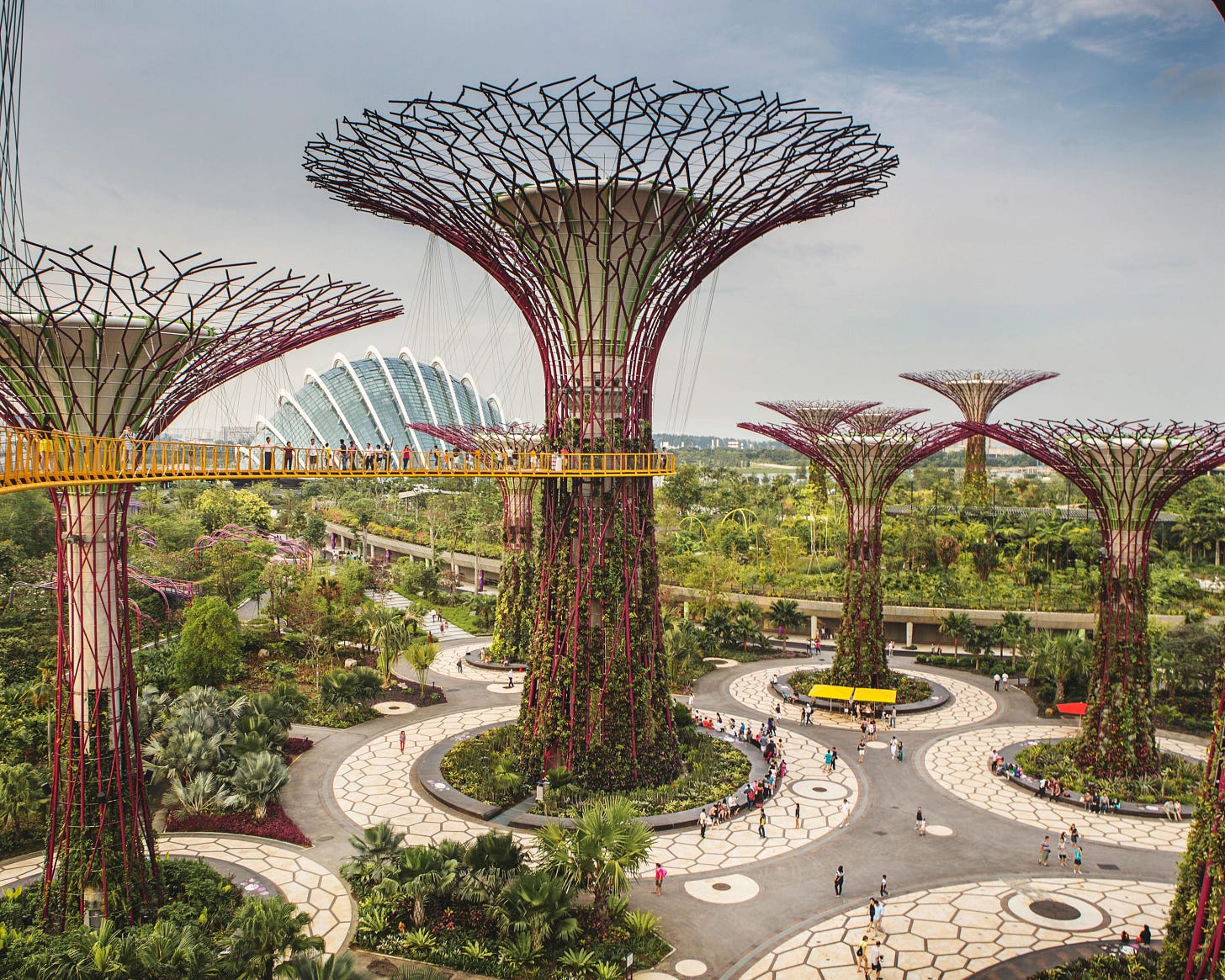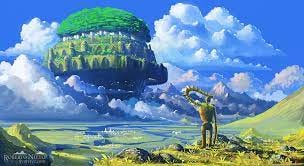Solarpunk is the next big literary-design movement
Can we imagine a future somewhere between TRON City and the Shire? We usually don't–but should and, perhaps, must.
What do AOC, venture capitalists, and gamers have in common? For one: a recent embrace of “solarpunk”, a growing cultural-aesthetic movement asking people what does a sustainable civilization look like, and how can we get there? This is more radical, and critical, than it sounds.
Why solarpunk?
Think of your favorite science fiction franchises. For me, it’s Dune by Herbert and Three-Body by Liu, both literary space operas in the midst of major motion picture adaptations. Maybe yours is The Matrix, Aliens, Interstellar, Blade Runner, Guardians of the Galaxy, Terminator, or Star Wars. Now, imagine a future version of your country 100 years from today. Your vision is probably heavily influenced by those media and includes dystopic elements like barren wastelands, pervasive surveillance, rogue robots and warlords, malevolent AI, interplanetary resource conquests and plagues, or insidious drug and video game use. As fascinating and rich as these worlds may be, I wouldn’t wish any of them upon my ancestors. (Nor would I relegate them to a fantasy-world past where the best hope against disease, starvation, conflict, and monsters is wise old mages.)
We shouldn’t discredit dystopian media; works like Orwell’s 1984 or Huxley’s Brave New World have undoubtedly-and-by-design scared us enough to protect our society from the worst-case scenarios posed by capitalism, fascism, bigotry, or colonialism. Science fiction reliably provides a blueprint of what could go horribly wrong, but it (or fantasy) rarely provides a blueprint of what could go terrifically well.
Where are the visions full of community picnics in exotic green fields, affordable houses grown from fungi, ultramarathons for centenarians, self-healing clothing, or beneficial relationships with powerful drugs, immersive games, exquisite food, and wild nature?
These worlds could actually be our future, but only if we can stay motivated, creative, and long-viewed as a society. Take slaughter-free cell-cultivated meat. It was first envisaged in a SciFi novel in 1897, and now, 126 years later, US consumers can finally eat it (after approval for sale by the USDA and FDA in June 2023). To quote Atwood, who envisioned something similar (chickienobs) in Oryx and Crake in 11 years before the first (of over 100) cultivated meat companies was formed in 2012: life imitates art.

Why now and what again?
Solarpunk art has mainstream appeal, and now has mainstream attention to help address mainstream issues like climate change. About 15 years ago, indie designers like Matt Staggs, John Robert, Olivia Louise, and Adam Flynn were crafting the Solarpunk aesthetic and sparking a cascade of think-pieces. But now, Solarpunk doesn’t just exist on the fringes of the blogosphere: there’s a crowdfunded solarpunk video game, a university program, a Reddit community, a media company, a web magazine, at least 18 “solarpunk” Spotify playlists, a forthcoming brewery, ~100 Tik Tok accounts, a wikipedia page, and venture capital firms. In an August 2023 livestream, Representative Alexandria Ocasio-Cortez even shouted out the Solarpunk movement.
Solarpunk is different from the popular futurisms like cyberpunk, biopunk, or steampunk, which focus on the implications of computing, biotechnology, and mechanization, respectively– as opposed to green tech like solar energy, as with solarpunk. They’re all “punk”–counter cultural aesthetic movements–but only solarpunk imagines not just resistance against society's harmful forces, but victory against them. Victory is achieved through responsible technological, cultural, ecological, and economic progress; through the evolution of the “social organism” of humanity as coined by Le Guin.
As a grassroots movement, there’s no formal tribunal of solarpunks, but it usually describes futures that are pleasant, sustainable, and ambitious; optimistic and inclusive without being necessarily utopian. Common themes are community-orientation, harmony with nature, craftsmanship, regenerative farming, anti-bigotry, anti-exploitation, environmental justice, feminism, true cost accounting, and industrial ecology.
The false dilemma of techno-maximalism
Solarpunk helps resolves the false choice between working towards a more rustic society and a more technological on. In James Cameron’s The Avatar; there is cultural opportunity space somewhere between the fully-indigenous Na’vi and fully-technical human invaders.
In the agri-food space where I work, there is profound distrust between the regenerative agriculture and cellular agriculture movements, although I would argue that both family ranchers and cultivated meat researchers share the same goal of feeding the world while liberating society, animals, and the land from destructive industrial animal agribusiness. I hope both have a place in our future. Indeed, it is just as myopic to avoid application of new tools because they didn’t exist 200 years go as it is to pretend that all progress is good, but to dream-away technology in favor of purely pastoral society would be a sad Harrison Bergeron-ification of humanity.
Solarpunk should not be be a tool of anti-human ecofascism, rustic luddism, or corporate greenwashing. It just asks that instead of giving into “climate doomism” to imagine verdant landscapes, clean air for our ancestors, perfect public transit, responsible mastery of the arts and sciences, the invention of new institutions and abandonment of bad ones, and disruption of dirty industries and plutocracy.
Solarpunk asks us to consider a middle ground, to imagine the ways in which we could responsibly grow the economy hand-in-hand with our connection to the land and to each other. It is hard to imagine this world, but that is the point. Whether designing digital media or crafting in the meatspace, each creative act contributes meaningfully to the collective imagination and therefore a better chance at a better future.
State of the art
Some incredible artists have already begun the solarpunk imagining, like in Coogler’s Black Panther, Miyazaki’s Castle in the Sky, Le Guin’s Always Coming Home, and in the Usonian architecture of Frank Lloyd Wright, in “earthship” homesteads, at the Arcosanti arcoecological city, in remembrances of suppressed indigenous wisdom like Kimmerer’s Braiding Sweetgrass, and in your fancy countertop herb garden, neighborhood agroforest, or local urban vertical farm.
Flynn challenges solarpunks to think big, to think in “cathedral time”. Indeed, what could humans accomplish with a 500-year Great Wall-level effort leveraging our modern breakthroughs in biotechnology, telecommunications, and medicine? Turn the Great Pacific Garbage Patch into a floating eco-city that runs on plastic, solar, and kelp farming? Make a space elevator to move our mining industry to the Moon instead of mountaintops? Growing all our meat, egg, dairy, silk, and tropical forest products through cellular agriculture? Planting free orchards that grow delicious medicines? 300 year life spans for all?
Positivity and ingenuity could give us these things, in time, though the road to paradise is paved by mistakes and full of peril. Technology has given us many wonders already, but it has also given us the Facebook algorithm, millions of Shake Weights sitting in garbage dumps, and a climate crisis. We must remain vigilant against corporate greenwashing and not lose sight of immediate problems, but we must also cultivate optimism in the collective imagination; we must dream dreams that steer the unstoppable social organism towards good.
With the ongoing strikes of the Writers Guild of America and Screen Actors Guild, our media landscape is prepared for a reboot (no–not another superhero fantasy– a creative reset). When new scripts and shows come out, demand more fresh ideas, more solarpunk visions in the mainstream. But it’s not just up to Hollywood. Social change wells up through normal people in challenging times. Amidst great struggle, optimism can be a radical act, a punk act. So, join us, solarpunks; lend your creative spark and technical expertise to manifest visions of abundance, balance, and peace for our planet.
Hi, this is the 11th edition of Fifth Industrial, a blog scouting emerging environmental biotechnologies and strategies. See the posts on plant cell culture, cellular agriculture, mycelium materials, synthetic silk, microbiomics, deep space food, alt cheese, alt protein CPG, biophilia, and US agricultural innovation engines.





Problem is utopian thinking in general, which always leaves someone out and puts an elite in control of life decisions.
Enjoyed reading this on different ideals on how sustainability intersects with technology. Also a big fan of the Three-Body trilogy